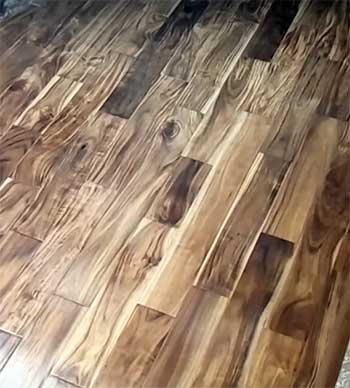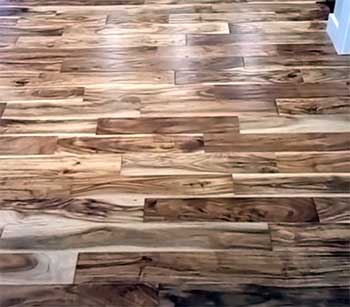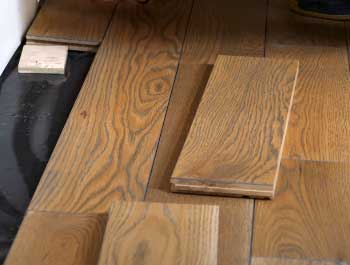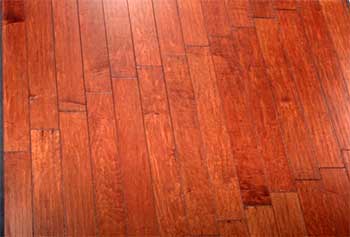I’m thrilled to share why acacia engineered wood flooring has won me over. Its stunning looks, durability, and budget-friendly price make it a fantastic pick for any home.
Whether you’re sprucing up a cozy living room or a bustling kitchen, this flooring brings warmth and character without breaking the bank. Trust me, once you see its rich, varied hues and feel its sturdy surface underfoot, you’ll be hooked.
Let’s explore my experience, the pros, the not-so-great parts, maintenance tips, and how it stacks up against other brands!
My Experience With Acacia Engineered Wood Flooring

When I decided to renovate my home last year, I was on a mission to find flooring that looked luxurious but didn’t cost a fortune.
After weeks of research and endless samples, I stumbled upon acacia engineered wood flooring, and it was love at first sight.
The moment I laid eyes on the planks at my local flooring store, I was mesmerized by their swirling grain patterns and warm, amber-to-mahogany tones.
No two planks were alike, and that uniqueness felt like a little gift from nature, perfect for my eclectic living space.
Installing it was a breeze—or so my contractor told me. I went with engineered acacia because I live in a humid area, and I’d heard horror stories about solid wood warping in damp conditions.
The planks, with their plywood base and acacia veneer, clicked into place over my concrete subfloor without a hitch. The process took just a couple of days, and I was walking on my new floors before I knew it.
What struck me immediately was how comfortable they felt underfoot—hard enough to withstand my dog’s enthusiastic sprints but soft enough to feel cozy.
Living with acacia flooring has been a delight. Spills from my toddler’s juice cup?
No problem—a quick wipe, and they’re gone. The color variations hide dirt like a champ, so I don’t stress about constant cleaning. I’ve had friends over who couldn’t stop raving about how “expensive” it looks, and I just smile, knowing I didn’t blow my budget.
Sure, it’s not perfect (we’ll get to that), but after a year, my floors still look as vibrant as day one. It’s been a game-changer for my home’s vibe and my peace of mind.
Pros of Acacia Engineered Wood Flooring

- Eye-Catching Beauty That Steals the Show
Let’s talk about the star of the show: acacia’s appearance. The first thing you’ll notice is its jaw-dropping color palette. From deep browns to reddish auburns and pale bronze, every plank is a work of art.
The wavy, swirling grain patterns give your floor a one-of-a-kind character that makes generic oak or maple look plain in comparison. I love how my living room feels like a cozy, high-end retreat, and guests always ask, “What kind of wood is this?”
You can leave it natural or stain it to match your style—it’s like a chameleon that fits any decor.
- Tough as Nails for Busy Homes
Acacia is a beast when it comes to durability. With a Janka hardness rating of around 1750 (and some species hitting 2300), it’s tougher than oak or maple. In my house, with a rambunctious dog and a toddler who loves dropping toys, this flooring holds up like a champ.
Scratches?
Barely noticeable. Dents? Haven’t seen one yet. It’s perfect for high-traffic areas like hallways or kitchens. Even my clumsy moments—like dropping a heavy pan—haven’t left a mark. If you’ve got a lively household, acacia’s got your back.
- Moisture Resistance for Real Life
One of my favorite things about acacia engineered wood is its moisture resistance. Unlike solid hardwood, which can warp or cup in humid conditions, the engineered version’s plywood base makes it more stable.
Living in a humid climate, I was worried about my floors buckling, but acacia has been rock-solid. It’s naturally resistant to mold and mildew, too, which is a huge plus for kitchens or bathrooms. Just don’t let spills sit too long—wipe them up quick, and you’re golden.
- Budget-Friendly Luxury
You’d think flooring this gorgeous would cost an arm and a leg, but acacia engineered wood is surprisingly affordable. I paid around $3.50 per square foot for mine, compared to $8 or more for solid exotic hardwoods like teak or mahogany. Installation was cheaper too, since engineered planks are easier to lay down than solid wood.
If you’re on a budget but want that high-end look, acacia delivers without making you wince at the price tag. Plus, machine-scraped finishes can save you even more compared to pricier hand-scraped options.
- Eco-Friendly and Sustainable
I’m all about making greener choices, and acacia fits the bill. These trees grow fast—sometimes six to eight feet a year—so they’re a renewable resource compared to slow-growing oaks.
Many suppliers are FSC-certified, ensuring responsible harvesting. Knowing my floors didn’t harm the planet gives me peace of mind, and it’s a win for both style and conscience.
Not-So-Good Parts of Acacia Engineered Wood Flooring
- Short Plank Lengths Can Feel Busy

One thing that caught me off guard was the shorter plank lengths.
Acacia trees are more like shrubs, so planks typically max out at four feet, unlike the longer runs you get with oak or maple.
In my open-plan living area, this created a basket-weave effect that’s stunning but can feel too busy in larger spaces.
If you’re after a sleek, modern look with long, uniform planks, you might find acacia’s shorter lengths a bit chaotic.
It’s a personal taste thing—my quirky decor loves it, but it’s not for everyone.
- Tricky Installation for DIYers
While my contractor made installation look easy, I’ve heard acacia’s hardness can be a pain for DIYers. Its density (that same Janka rating I bragged about) means cutting and nailing can be tough without the right tools.
I didn’t attempt it myself, but friends who did said it was a workout. If you’re not handy or don’t have a pro, you might face some frustration. Engineered acacia is easier than solid, but it still requires precision to avoid gaps or uneven cuts.
- Potential for Warping if Not Handled Right
Acacia’s moisture resistance is great, but it’s not foolproof. If the wood isn’t properly dried during manufacturing or acclimated to your home’s humidity before installation, it can shrink or buckle.
I dodged this bullet by buying from a reputable supplier and letting the planks sit in my house for a week before installation. But if you skip these steps or live in a super dry climate, you might see gaps or warping over time. It’s not common, but it’s a risk to keep in mind.
- Limited Color Consistency
The color variation that I adore can be a downside for some. If you’re a stickler for uniformity, acacia’s wild mix of hues might drive you nuts. Matching planks for repairs or additions is tricky since no two are identical.
I had to replace a damaged plank in my hallway, and finding an exact match was a hassle. It’s not a dealbreaker, but it’s worth knowing if you’re picky about a cohesive look across your floors.
- Slightly Higher Cost Than Some Alternatives
While acacia is cheaper than exotic hardwoods, it’s pricier than some budget options. I could’ve saved a bit with laminate or vinyl plank, which run as low as $0.80 per square foot compared to my $3.50 for engineered acacia.
If you’re pinching pennies, you might feel the sting, especially if you’re covering a large area. For me, the extra cost was worth it for the look and durability, but it’s something to weigh if your budget is tight.
Maintenance Tips For Acacia Engineered Wood Flooring
- Regular Sweeping Keeps It Pristine
I swear by my broom for keeping my acacia floors looking sharp. The varied colors hide dirt well, but dust and debris can build up in high-traffic spots like my entryway. I sweep every couple of days to prevent scratches from gritty particles.
A soft-bristle broom or a dry microfiber mop works best—avoid anything too abrasive. If you’ve got a vacuum, use the bare-floor setting to avoid scuffing the finish. It takes five minutes and keeps your floors looking fresh.
- Damp Mopping Is Your Friend
Once a week, I give my floors a quick damp mop, and they shine like new. No fancy cleaners needed—just a well-wrung mop with warm water or a mild wood-safe cleaner. I use a flat mop to avoid soaking the wood, since excess water can seep into the joints and cause issues.
For tough spots, like juice stains from my kid, a little dish soap in the water does the trick. Just don’t let puddles sit—wipe them up fast to keep that moisture resistance working its magic.
- Use Mats and Rugs Strategically
I learned early on that mats are a lifesaver. I’ve got one at every entrance to catch dirt before it hits the floor, and a big rug in my living room to protect high-traffic zones. They cut down on wear and tear, especially near the door where my dog tracks in mud.
Look for low-pile rugs with non-slip pads to avoid scratches, and shake them out regularly. It’s a small step that saves you from constant sweeping and keeps your floors looking flawless.
- Refinish Every Decade or So
My floors still look great after a year, but I’m told refinishing every 10 years keeps them sparkling. Engineered acacia has a thinner veneer than solid wood, so you’ve got maybe two or three refinishing cycles before you hit the plywood core.
When the time comes, I’ll hire a pro to sand and reseal with a durable polyurethane finish. It’s not cheap, but it restores that glossy, luxurious look. Between refinishes, a coat of furniture wax every few years keeps the shine alive without much hassle.
- Control Humidity to Prevent Problems
Living in a humid area, I keep a close eye on my home’s humidity levels. A dehumidifier keeps things stable at 40-50% relative humidity to prevent warping or gaps. Before installation, I let the planks acclimate in my house for a week to adjust to the environment.
If you’re in a dry climate, a humidifier might be your best friend. Check with a moisture meter if you’re paranoid—it’s a small investment for peace of mind.
Comparison of Acacia Engineered Wood Flooring With Other Brands
When I was picking out my acacia engineered wood flooring, I checked out a few other brands to see how they measured up. Here’s how acacia stacks up against American Spirit Hardwood Flooring, Millstead Solid Hardwood Flooring, and Stuga Flooring, based on my research and chats with friends who’ve tried them.
Each has its strengths, but acacia’s unique vibe and practicality won me over.
- Acacia Engineered Wood Vs. American Spirit Hardwood Flooring

American Spirit Hardwood Flooring offers a mix of engineered and solid options, focusing on domestic woods like oak and hickory.
Their engineered planks, priced around $4 to $8 per square foot, are comparable to my acacia’s $3.50.
I love acacia’s wild, exotic grain patterns, which give my floors a standout look, while American Spirit leans toward classic, uniform finishes that feel a bit safer.
Their durability is solid, with a 25-year warranty, but acacia’s higher Janka rating (1750-2300) outmuscles their oak (around 1200).
American Spirit’s planks are longer, up to seven feet, which suits larger, modern spaces better than acacia’s shorter four-foot planks. However, acacia’s moisture resistance and eco-friendly fast-growing source tipped the scales for me, especially in my humid climate.
- Acacia Engineered Wood Vs. Millstead Solid Hardwood Flooring

Millstead Solid Hardwood Flooring, often found at Home Depot, is all about traditional solid woods like oak and maple, priced between $3 and $6 per square foot.
Unlike my engineered acacia, Millstead’s solid planks can be refinished multiple times, which is great for long-term use.
But solid wood is trickier to install and less stable in humid conditions—my contractor warned me about potential warping, which scared me off given my damp climate.
Acacia’s engineered construction makes it a breeze to install over concrete, and its mold resistance is a lifesaver.
Millstead’s simpler grain patterns didn’t grab me like acacia’s vibrant, swirling hues. If you’re in a dry climate and love classic looks, Millstead’s a contender, but acacia’s modern flair and stability won my heart.
- Acacia Engineered Wood Vs. Stuga Flooring

Stuga Flooring, a premium brand, specializes in engineered wood with a Scandinavian-inspired aesthetic, priced from $5 to $10 per square foot. Their minimalist designs, often in oak or ash, are gorgeous for sleek, modern homes, but I found acacia’s bold colors and patterns more exciting for my eclectic style.
Stuga’s planks are super durable, with a 30-year warranty, and their thicker wear layers allow more refinishes than acacia’s thinner veneer. However, acacia’s lower price point and natural mold resistance give it an edge for budget-conscious folks in humid areas.
Stuga’s longer planks (up to eight feet) create a seamless look, but acacia’s shorter planks add character that I adore. If you want understated elegance, Stuga’s your pick; for vibrant personality, acacia shines.
Frequently Asked Questions (FAQ)
Acacia’s shorter plank lengths (around four feet) can create a busy look in large spaces, which might not suit modern, minimalist tastes. Its hardness makes DIY installation tricky, requiring specialized tools. If not properly dried or acclimated, it risks warping or shrinking, especially in dry climates. The varied colors make matching replacement planks tough, and it’s pricier than budget options like laminate or vinyl, costing $2.60 to $8 per square foot for engineered acacia.
Absolutely! Acacia’s durability (Janka rating 1750-2300), moisture resistance, and stunning color variations make it ideal for busy homes. It’s tougher than oak or maple, resists mold, and holds up in high-traffic areas. Engineered acacia is budget-friendly ($2.60 to $8 per square foot) and stable in humid conditions, offering a luxurious look without the exotic hardwood price tag. Just ensure proper acclimation and maintenance to avoid warping.
It’s tough to crown one brand, but Hurst Hardwoods stands out for its stellar reputation and wide selection, including acacia, with competitive pricing ($3 to $6 per square foot). Mannington and Mohawk also shine for their durable, eco-friendly options and long warranties (up to 50 years). Jasper and Saso are top picks for engineered acacia specifically, balancing quality and affordability. Your best bet? Compare quotes from reputable suppliers to find the perfect fit.
Engineered wood, including acacia, has a thinner veneer, limiting refinishing to two or three cycles before hitting the plywood core. It’s pricier than laminate or vinyl, averaging $3 to $8 per square foot. Installation can be challenging for DIYers due to the need for precise cuts and humidity control to prevent warping or gaps. While more stable than solid wood, extreme conditions can still cause issues if not properly managed.
Why You Should Choose Acacia Engineered Wood Flooring?
I can’t recommend acacia engineered wood flooring enough. Its breathtaking beauty, rock-solid durability, and eco-friendly credentials make it a standout choice. From its vibrant, varied hues to its ability to handle my chaotic household, it’s transformed my home without draining my wallet.
Whether you’re after a luxurious look or a floor that can take a beating, acacia delivers. Trust me, you’ll fall in love with its charm and practicality—make the leap and elevate your space today!
